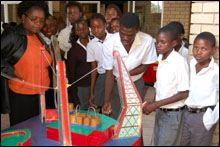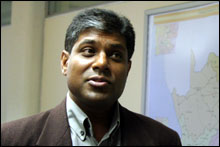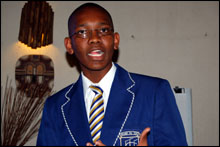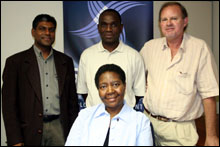Independent evaluation shows SAEON Education Outreach to be well on target
|
In a move described as “brave” by the international education outreach
community, SAEON commissioned an independent evaluation of the impact
of its education-outreach programme at the SAEON Ndlovu Node from 2004
to 2006.
The report was presented during the 4th World Environmental Education Conference which was held in June this year, the first on the African continent. The Conference was attended by nearly a thousand delegates from over one hundred countries.
The report was also received with interest by other professional audiences - the education outreach officers of the National Research Foundation (NRF) and the SAEON Network of Education Experts. It stimulated an NRF-wide debate, led by the South African Agency for Science and Technology Advancement (SAASTA), on best practice for evaluation processes.
The report was also presented to the Phalaborwa beneficiaries of the programme.
Methodology
Independent evaluator Rajen Pillay says that the primary objective of the evaluation was to determine what new knowledge the beneficiaries (learners, educators, principals and partner organisations) gained from the programme, and what actually enriched their knowledge.
For this purpose, he used qualitative as well as quantitative methodology. Altogether 173 participants from 8 schools in the Ba-Phalaborwa region were interviewed. Documents, photographs and questionnaires were analysed, and some of the insights were based on his own observations at the schools and of SAEON’s interaction with the learners.
Strengths
Clear vision and focus on key profile activities, educators and partner organisations were identified as programme strengths. Educators as well as learners experienced tremendous growth in scientific knowledge, awareness of science in everyday life and interest in science careers.
“SAEON’s Education Outreach programme exposed learners to experiences, new knowledge and career options they would probably never have been exposed to in the normal context,” says Rajen.
The exposure to scientists during awareness campaigns, workshops and holiday programmes has broadened their understanding and interest in environmental science, and has helped them to appreciate science in their daily lives. Even those learners interested in studying law said they were thinking of focusing on environmental law.
An important stereotype shift took place in that girl learners realised that careers in science were open to females as well as to males. Previously, they had rated themselves inferior to the boy learners. This is even more important given the acute shortage of women in science and directly addresses the national objective of getting more females involved in science careers.
Another positive spin-off of the programme is the leadership skills that the learners developed. Educators, school principals and learners said that the learners involved in the programme grew in confidence and demonstrated newly acquired leadership skills.
The educators interviewed said that the SAEON programme definitely raised their level of awareness of science and environmental science in particular. “Now when I teach in class I have a much clearer understanding of scientific concepts,” one of the educators said. SAEON’s projects have also increased their understanding of their local environment.
Educators subsequently also have a greater understanding of environmental problems, and this finds resonance in their teaching, adding extra impetus to the SAEON education outreach message. One of the educators described how, during a workshop, they were involved in the elephant culling debate in the Kruger National Park. “For the first time we were dealing with a real environmental issue,” she said, “not just a hypothetical one.”
Educators were also exposed to interesting models and techniques that they could take with them to the classroom and apply in their teaching. These included the use of drama and debates to stimulate creative thinking around environmental issues.
The educators voiced their approval of the Teachers Tearoom Forums that Joe Sibiya, the SAEON Ndlovu Node’s Education Outreach Officer, established at the Ndlovu Node to get the teachers to share issues and experiences in an informal but focused way, and to become involved in the planning of the National Science Week and Women in Science programmes.
The school principals interviewed said that there had been a noticeable increase in overall performance in mathematics, biology and geography in those grades where learners were exposed to SAEON programmes.
In response to a question about what would happen if SAEON were to pull out of the Ndlovu Node, school principals, educators and learners alike showed great concern.
SAEON partner organisations interviewed complimented the SAEON staff on their integrity, and said that they filled gaps in terms of expertise and the strengths they brought to joint projects.
Expert advice
Limitations were listed as too much focus on high-profile activities at the expense of other initiatives, and insufficient training in long-term environmental observation skills, a vital component not only in environmental sciences, but of SAEON as well.
The SAEON education outreach team members were advised to do a thorough needs-analysis of their key beneficiaries as beneficiaries work in their own contexts and within their own agendas. It was important for SAEON to align its education outreach programme with the school curriculum.
The SAEON team was also alerted to the fact that the learners enjoyed and learnt the most from those activities that were interactive. Learners specifically mentioned the cheetah project they were involved in at the Hoedspruit Endangered Species Centre and the aviation project at National Science Week (where some girl learners were astonished to learn that women could become pilots too).
The SAEON education outreach team members were advised to do regular follow-ups on their initiatives, become more involved in school management, and to involve increasing numbers of learners in their programmes.
Conclusion
In conclusion, Rajen gave the SAEON education outreach team a much-prized blue grading in terms of their impact on their beneficiaries – the highest grading there is.
His overall conclusion: “SAEON is making a difference; and a very valuable difference at that!”
Joe Sibiya said, "The evaluation process has been scary experience, but worth going through”.
Sibongile Mokoena, SAEON’s Education Outreach Coordinator said that the strengths and challenges highlighted in the evaluation provide lessons for future growth in line with the SAEON mandate and objectives of the programme.
“We now have a clear path ahead,” she added.
The Evaluation report can be viewed at www.saeon.ac.za.
Feedback to beneficiaries
SAEON’s Education Outreach Coordinator, Sibongile Mokoena and the SAEON Ndlovu Node’s Education Outreach Officer, Joe Sibiya, describe the momentous occasion when the report was presented to Phalaborwa learners, educators and school principals:
At a historic event in September, the Phalaborwa beneficiaries received, first hand, feedback on the evaluation. Copies of the evaluation report were presented at an elegant lunch in tranquil, fresh lowveld surroundings attended by selected educators, learners, principals, education officials and partner organisations.
Kabelo Setsiba, a learner from Frans Du Toit High School, a participant in ADVENVIRO Camp 2007 and the SAEON Holiday Programme, and an exceptional public speaker, said on behalf of the group, ”We sincerely thank SAEON, and its key representative Joe Sibiya, for organising the annual winter camp and ensuring that South Africa’s young people are exposed to nature conservation, teaching them the role they play in the environment and hopefully interesting them in pursuing a career in natural sciences. We will make sure that this long-term programme meets its objectives.”















